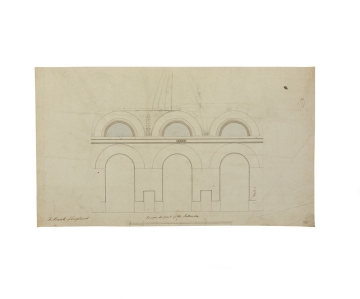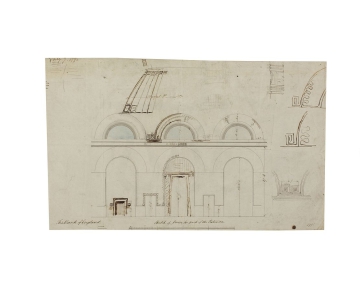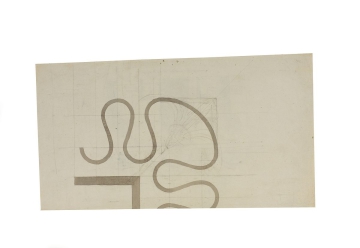
Browse
Reference number
Purpose
Aspect
Scale
Inscribed
Signed and dated
- (12) 1795 (13) 1795, (Soane) July 7 1795 (14) 1795
Hand
Notes
The interior of the Rotunda was decorated with lines incised into the plaster (what Soane called 'sinkings'). Soane used Greek key patterns and an inventive wavy motif. Drawings 12 to 14 show, in Soane's hand, alternative designs for the decoration around the windows and within the ribs of the dome. Drawing 12 shows a leaf motif emerging from between Greek key patterns at the base of the lunettes and a design for the ribs of the dome to extend down to the cornice. Drawing 13 shows a Vitruvian door (similar to drawing 5) and variant Greek key patterns at the base of the lunettes. A pilaster capital, or cornice, is also shown with an acanthus motif. Drawing 14 is a curious design for the decoration between the lunettes, showing variant designs for a more freehand floral motif. The Rotunda tended toward a more understated decorative scheme.
Literature
Level
Sir John Soane's collection includes some 30,000 architectural, design and topographical drawings which is a very important resource for scholars worldwide. His was the first architect’s collection to attempt to preserve the best in design for the architectural profession in the future, and it did so by assembling as exemplars surviving drawings by great Renaissance masters and by the leading architects in Britain in the 17th and 18th centuries and his near contemporaries such as Sir William Chambers, Robert Adam and George Dance the Younger. These drawings sit side by side with 9,000 drawings in Soane’s own hand or those of the pupils in his office, covering his early work as a student, his time in Italy and the drawings produced in the course of his architectural practice from 1780 until the 1830s.
Browse (via the vertical menu to the left) and search results for Drawings include a mixture of Concise catalogue records – drawn from an outline list of the collection – and fuller records where drawings have been catalogued in more detail (an ongoing process).










